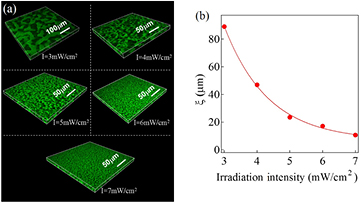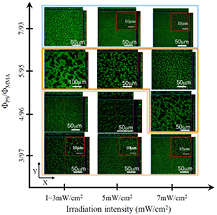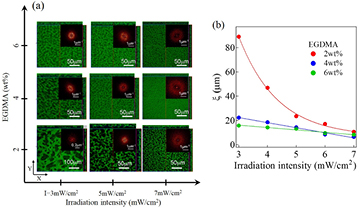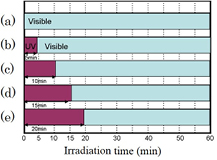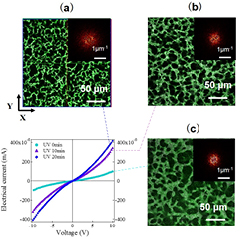Abstract
Polymer mixtures composed of double networks of a polystyrene derivative (PSAF) and poly(methyl methacrylate) (PMMA) were alternatively synthesized by using ultraviolet (UV) and visible (Vis) light. The PSAF networks were generated by UV irradiation to photodimerize the anthracene (A) moieties labeled on the PSAF chains, whereas PMMA networks were produced by photopolymerization of methyl methacrylate (MMA) monomer and the cross-link reaction using ethylene glycol dimethacrylate (EGDMA) under Vis light irradiation. It was found that phase separation process of these networks can be independently induced and promptly controlled by using UV and Vis light. The characteristic length scale distribution of the resulting co-continuous morphology can be well regulated by the UV and Vis light intensity. In order to confirm and utilize the connectivity of the bicontinuous morphology observed by confocal microscopy, a very small amount, 0.1 wt%, of multi-walled carbon nanotubes (MWCNTs) was introduced into the mixture and the current–voltage (I–V) relationship was subsequently examined. Preliminary data show that MWCNTs are preferentially dispersed in the PSAF-rich continuous domains and the whole mixture became electrically conducting, confirming the connectivity of the observed bi-continuous morphology. The experimental data obtained in this study reveal a promising method to design various scaffolds for conducting soft matter taking advantages of photopolymerization-induced phase separation.
Export citation and abstract BibTeX RIS

Original content from this work may be used under the terms of the Creative Commons Attribution 3.0 licence. Any further distribution of this work must maintain attribution to the author(s) and the title of the work, journal citation and DOI.
1. Introduction
Interpenetrating polymer networks (IPNs) are defined as a kind of molecular composites composed of two different non-intersecting networks synthesized by polymerization and cross-link [1, 2]. Depending on the synthesis procedure, i.e. the networking reactions, these IPNs have been divided into two categories: simultaneous IPNs (SIN-IPNs) and sequential IPNs (SEQ-IPNs). In the synthesis of simultaneous IPNs, the mixtures of two different monomers are polymerized in the presence of two corresponding cross-linkers, theoretically resulting in two non-intersecting independent polymer networks. On the other hand, in the synthesis of sequential IPNs, monomer I and its cross-linker I are polymerized first. Subsequently, monomer II and its corresponding cross-linker II are added into the mixture to construct the second networks. Eventually, the mixture of the two independent polymer networks can be synthesized. However, in practice, the formation of two different miscible non-intersecting polymer networks is often prevented by the phase separation between the two polymers during the synthesis. As a result, phase separated IPNs are obtained in most cases [3]. From the kinetic viewpoint, viscosity of the mixture increases with the reaction time because of the increase in both polymer conversion and molecular weight. This increment is further accelerated by the Trommsdorff–Norrish effect [4] (the so-called gel effect) which occurs during the polymerization. For both binary and ternary systems, the irradiation-time dependence of viscosity and molecular weight of the resulting polymers have been directly monitored during the photopolymerization process and the results were reported in detail elsewhere [5, 6]. During the polymerization and the cross-linking processes, the inhomogeneity of the reacting mixtures keeps increasing with polymerization time and is gradually frozen due to the glassification of the mixture. As a consequence, this inhomogeneity does not only generate a broad distribution of the glass transition temperature, but also gives rise to the disorder and non-regularity of the resulting morphology upon phase separation [7]. The consequence of this inhomogeneity is broadening of the periods of the bi-continuous structures and/or randomization of the resulting morphology [8, 9].
In order to reduce the inhomogeneity associated with the reactions and to efficiently control the morphology of these IPNs, we report here the preliminary experiments using light irradiation with two different wavelengths: one is in the region of ultraviolet (UV) and the other is in the visible (Vis) range. For full-IPNs, the resulting elastic strain induced by the polymerization strongly depends on the yield of the two networking reactions and as a consequence, the final morphology can be greatly affected by the tightness of the resulting networks [10]. This tightness of the two networks is determined by the cross-link density which could be independently manipulated and controlled by using two different wavelengths of UV and Vis light as described in this study.
In this paper, we demonstrate that by using both UV and Vis light, the networking reactions of polystyrene-poly(methyl methacrylate) full-IPNs can be independently carried out and controlled. Furthermore, by varying the ratio of irradiation time using UV and Vis, which corresponds to changing the tightness of the two PS and PMMA networks, the length scale distribution of the bi-continuous morphology can be modified, suggesting a way to improve the transport properties of these IPNs. Finally, the connectivity of the bi-continuous morphology generated by this two-wavelength irradiation method is experimentally verified by taking advantages of the selective dispersion of multi-walled carbon nanotubes (MWCNTs) into the PSAF-rich component, providing a new approach to design conducting soft matter by light irradiation.
2. Experimental
2.1. Materials
Polystyrene doubly labeled with anthracene and fluorescein (PSAF, Mw = 3.1 × 105, Mw/Mn = 2.8) was prepared by following the synthesis procedure described previously [11]. As indicated in figure 1, upon irradiation with 365 nm UV light through a bandpass filter (Asahi Spectra USA Inc, California), anthracene moieties labeled on the PSAF component undergo photodimerization, resulting in the PSAF networks. On the other hand, the fluorescein moieties labeled on PSAF chains will help to identify the PSAF-rich component in the morphology by using the fluorescence mode of a laser-scanning confocal microscope (LSCM, Zeiss Inc., Model LSM5). For convenience, the PSAF-rich component is indicated by green color in the morphology. On the other hand, photopolymerization of methyl methacrylate (MMA, Wako Chemicals, purified by conventional method) in the presence of ethylene glycol dimethacrylate (EGDMA) (Sigma-Aldrich, Tokyo) as a cross-linker, was induced by irradiation with visible light (λ > 420 nm) using a sharp-cut filter (SC-42, Fuji Film Inc, Japan). To independently polymerize and cross-link the PMMA component, the co-initiator system camphorquinone (CQ)/ethyl 4-(dimethylamino) benzoate (both purchased from Tokyo Kasei, Inc., the purity is larger than 98%) was used as a dual photoinitiator to induce the polymerization of MMA monomer with visible light [12]. At the same time, the cross-link reaction of PMMA was carried out in the presence of ethylene glycol dimethacrylate (EGDMA, Sigma- Aldrich, Japan). The mechanism of the initiation by the CQ/amine co-initiator was investigated in detail and is known to occur via hydrogen abstraction of amines by the triplet state of CQ, i.e the electron/proton transfer mechanism [13]. It is worth noting that CQ itself can initiate polymerization but not efficient [14] and can also undergo photobleaching during irradiation [15]. Taking into account this feature, photo-polymerization of MMA in this study was carried out using CQ/Amine dual initiator with slightly excess of CQ. It is worth noting that the polymerization using visible light has been largely utilized in the field of dental materials because UV can be harmful to human body [16]. In this study, the photopolymerization of MMA was carried out in a home-made Pyrex cell under a LSCM to in situ monitor the polymerization-induced phase separation as described previously [17]. The chemical structure of the polymer and the co-initiator were illustrated in figure 2.
Figure 1. Mechanism of networking reaction and phase separation.
Download figure:
Standard image High-resolution imageFigure 2. Chemical structures of the compounds used in this study: (a) polystyrene doubly labeled with anthracene and fluorescein (PSAF); (b) camphorquinone (CQ) and (c) ethyl 4-dimethylaminobenzoate (EDB).
Download figure:
Standard image High-resolution imageMWCNTs were purchased from Cheap Tube Inc. (Vermont, USA) and were used without purification. The purity of these MWCNTs was estimated by Raman spectroscopy where the indication of purity is given by the ratio of the D-line (1347 cm−1) and the G-line (1585 cm−1) [18]. From the empirical formula proposed in [19], it was found that the purity of the MWCNTs used in this study is 70%.
2.2. Irradiation procedure using two wavelengths UV and Vis light
The UV–vis absorption spectra of the polymer PSAF and camphorquinone are shown in figure 3. A high pressure Hg–Xe lamp (300 W, Moritex Inc., Japan) equipped with an optical fiber was used as a light source. Anthracene moieties on the PSAF chains are excited with the 365 nm via a bandpass filter (Asahi Spectra USA Inc.), whereas the visible lines of a Hg–Xe lamp was extracted to excite the co-initiator CQ/amine by using a sharp-cut filter SC-42 (Toshiba, Japan). By the combination of these two kinds of filters, anthracene and camphorquinone can be separately excited to independently generate the two networks PSAF and PMMA in the mixture. On the other hand, the fraction of each network component can be independently regulated by changing the intensity of these two wavelengths.
Figure 3. Absorption spectra of PSAF (left) and camphorquinone (CQ) (right). Characteristic transmission of the optical filters is indicated by the boxes in the figure.
Download figure:
Standard image High-resolution image2.3. Imaging and analysis of the resulting morphology
The resulting morphology of the polystyrene-poly(methyl methacrylate) (PS-PMMA) full-IPNs was in situ monitored under a LSCM (LSM-5, Zeiss Inc.) during the irradiation process as previously reported [11]. With the procedure of using two different wavelengths as described above, PSAF and PMMA components can be independently photo-cross-linked and photopolymerized by switching the appropriate optical filters installed in the front of the Hg–Xe lamp. Absorbance of the anthracene moieties on the PSAF chains was in situ monitored under a UV–vis spectrophotometer (UV-1600, Shimadzu, Japan). On the other hand, the polymerization kinetics of MMA was also monitored in situ under a Fourier transform infrared (FTIR) spectrometer (Perkin-Elmer, Model Spectrum GX). The information on the networking kinetics of the PSAF and PMMA components was respectively obtained from the dependence of both the UV–vis and FTIR absorbance on irradiation time. The morphology of the mixture resulting from irradiation using both UV and Vis light was in situ observed under the laser-scanning confocal microscope (LSCM, LSM-5, Zeiss Inc.). All the imaging conditions as well as the method of morphology analysis using 2D-fast Fourier transform (2D-FFT) are described in detail in previous publications [5, 6, 17, 20].
2.4. Current–voltage characteristics of PSAF/MMA/MWCNTs mixtures
The current–voltage (I–V) characteristics of the PSAF/MMA/MWCNTs mixtures were measured by using the two-probe method as reported previously [21, 22]. Briefly, gold electrodes with the diameter 50 nm were deposited on the surfaces of the mixture and the sample was set in a vacuum chamber (Ulvac, Model VPC-260F) with a pressure less than 2 × 10−3 Pa. The mixtures were then placed on a stage in the vacuum chamber equipped with current probes connected to a voltage–current source monitor (Advantest, Model R6245, Tokyo). The currents were then measured in vacuo as a function of applied voltage varying from −10 V to 10 V with an interval of 0.5 V. The leak current was obtained beforehand from the baseline (offset) measurements by dismounting one current-probe from the sample surface.
3. Results and discussion
3.1. Photocross-link and photopolymerization kinetics: evidence for the formation of the two independent networks
The polymerization kinetics of MMA in a PSAF/MMA (5/95) mixture irradiated over 60 min with the intensity I = 3 mW cm−2 under visible light was monitored by FTIR and displayed in figure 4(a). It was found that the FTIR absorbance of MMA exhibits a sigmoidal curve as irradiation time increases, revealing the typical behavior of the Trommsdorff–Norrish effect of free radical polymerization kinetics characterized by an inflection point at 40 min of irradiation. Eventually, the polymer conversion Φ tends to approach a constant value at long irradiation time. On the other hand, as shown in figure 4(b), no conversion of PMMA was observed under irradiation with 365 nm as seen from the same figure. In contrary, upon irradiation with 365 nm UV light, absorbance of the anthracene moieties labeled on the PSAF chain gradually decreases with irradiation time, indicating that the anthracene moieties on the PSAF component undergo photodimerization, generating the PSAF networks in the mixture. It was found that the decay of the absorbance of anthracene can be expressed by the Kaulrausch–Williams–Watts (KWW) empirical function [23, 24] with the exponent β = 0.26. It is worth noting that irradiation using visible light with wavelengths longer than 420 nm did not alter the absorbance of MMA as illustrated in figure 4(b), indicating that the C=C double bonds of MMA monomer was protected under this particular condition. From the above results, we can conclude that the two networks PMMA and PSAF can be independently generated by utilizing UV and Vis light with the combination of filters shown in figure 3.
Figure 4. Selectivity of the cross-link reactions observed by UV–vis photometer: (a) preferentially networking of the PMMA component; (b) preferentially networking of the PS component.
Download figure:
Standard image High-resolution image3.2. Dependence of the polymerization of MMA on the visible light intensity
Since the mixture only undergoes phase separation after the polymerization of MMA monomer promotes to some certain extent by visible light irradiation, the effects of visible light intensity on the polymerization of MMA were examined hereafter to gain the knowledge for controlling morphology by visible light. According to the experimental data shown in figures 4(a) and (b), it is worth noting that only semi-IPNs were obtained in this case because visible light cannot trigger the cross-link reaction of the PSAF component. As reported previously for photopolymerization-induced phase separation, under low light intensity, the phase separation proceeds via nucleation and growth process and is eventually terminated with droplet morphology [20]. On the other hand, under strong light intensity, the mixture enters the spinodal region with co-continuous structures that emerge and grow with time [17]. For the polymers with the Tg (the glass transition temperature) higher than the experimental temperatures, these transient co-continuous structures will be kinetically frozen during the polymerization, resulting in spatially speriodic structures. Shown in figure 5(a) is the effect of visible light intensity on the final morphology in 3D as observed by laser-scanning confocal microscopy. The stationary characteristic length scales of the morphology obtained after 60 min of irradiation under different visible light intensity obtained by 2D-FFT are plotted versus irradiation time in figure 5(b). Obviously, the length scale of the bi-continuous structure gradually decreases with increasing the light intensity and tends to approach a constant value. It is worth noting that for the composition PSAF/MMA (5/95), all the emerging morphologies are bi-continuous structures for all the irradiation times. Therefore, this particular composition would be located in the vicinity of the critical point of the mixture.
Figure 5. (a) Morphologies of semi-IPNs observed for a PSAF/MMA(5/95) mixture irradiated with visible light to cross-link only the PMMA component, the green and black regions correspond respectively to the PSAF-rich and PMMA-rich phases; (b) dependence of the stationary characteristic length scales on the visible light intensity obtained for a PSAF/MA(5/95) mixture.
Download figure:
Standard image High-resolution imageThese results are in accordance with the polymerization kinetics obtained under different UV light intensities shown in figure 6. To facilitate the comparison, the dependence of the stationary characteristic length scales on the irradiation intensity is recast in the inset of figure 6.
Figure 6. Photopolymerization kinetics of MMA monomer in a PSAF/MMA (5/95) mixture monitored by FTIR. Inset: dependence of the stationary characteristic length ξ on irradiation time using visible light.
Download figure:
Standard image High-resolution image3.3. Dependence of phase separation kinetics on the initial composition
Shown in figure 7 is the stationary morphology of a PSAF/MMA mixtures with various initial compositions ranging from (3/97) to (7/93). These mixtures are irradiated by using visible light at room temperature (25 °C) to induce the polymerization of MMA in the mixtures. For a mixture with a given composition, phase separation takes place after a certain irradiation time, generating either droplet structures or bi-continuous structures. Generally, under low light intensity, phase separation occurs via the nucleation-and-growth process because the experimental conditions correspond to a 'shallow jump'. On the other hand, under irradiation with high light intensity, spinodal structure appears as high light intensity corresponds to a 'deep quench'. For a given PSAF/MMA composition, increasing the irradiation intensity leads to the transition from PSAF-rich (green) droplets in the PMMA-rich (black) matrix, through the bi-continuous morphology of PSAF-rich and PMMA-rich component as observed for the case of PSAF/MMA (5/95). Subsequently, the phase-inversion with the PMMA-rich (black) spheres dispersed in the PSAF-rich (green) matrix occurs, revealing a method of morphology control by changing the light intensity. Among these compositions, the one with the composition PSAF/MMA (5/95) exhibits bi-continuous morphologies under all the irradiation intensities ranging from 3 to 7 mW cm−2. It would be reasonable to conclude that for the composition (5/95), the polymerizing mixture always stays in the spinodal region of the mixture while the two-phase region is widened by the polymerization.
Figure 7. Morphology map obtained by irradiation with visible light for PSAF/MMA mixtures with various compositions ΦPS/ΦMMA. Inset: enlarged morphology for easy observation. The droplet and bi-continuous morphologies are discriminated by using frames with different colors.
Download figure:
Standard image High-resolution image3.4. Effects of the cross-linker concentration on the resulting morphology
To examine the effects of mobility on the resulting morphology, EGDMA was used as a cross-linker for the PMMA component. EGDMA was added to the mixture under three different concentrations 2, 4 and 6 wt%. The total irradiation time for all the experiments was set at 60 min, i.e. the reaction time required for completely freezing the phase separation in the mixture. The resulting morphology in the presence of the cross-linker EGDMA with different concentrations is illustrated in figure 8(a). From these results, one can conclude that as the cross-linker concentration increases, the characteristic length scales become smaller. Furthermore, for this particular PSAF/MMA(5/95) composition, within the range of light intensity (3–7 mW cm−2), all the morphologies obtained with the initial composition PSAF/MMA(5/95) exhibit bi-continuous morphology as revealed by the 'spinodal ring' obtained by 2D-FFT as depicted in the insets of the corresponding morphology. From the Bragg relation, ξ = 2π/qmax, where ξ is the period of the structure and qmax is the wavenumber corresponding to the maximum of the FFT intensity distribution, the characteristic length scales ξ are calculated and shown in figure 8(b). The effects of cross-linker on the time-evolution of the phase separation is not significant and seems to approach a limit at higher concentrations of EGDMA, particularly at high light intensity. Therefore, the behavior of cross-linkers resembles those of light intensity in the photopolymerization kinetics of MMA monomer shown in figure 6 and is originated from the limiting mobility in the mixtures under high concentrations of cross-linkers.
Figure 8. Effects of cross-link concentration (a) on the morphology map observed for a PSAF/MMA (5/95) mixture under various light intensities (the inset shows the corresponding 2D-FFT intensity distribution), and (b) on the stationary bi-continuous morphology observed under different light intensities.
Download figure:
Standard image High-resolution image3.5. Phase separation in full-IPNs induced by two independent networks under irradiation using two different wavelengths
In order to generate full-IPNs composed of two independent networks PS and PMMA, a PSAF/MMA(5/95) mixture was first irradiated using 365 nm UV light with the intensity 3.0 mW cm−2 to produce the PSAF networks. It is worth noting that under this irradiation condition, the mixture is located in the one-phase region without any morphology observable under an LSCM. After irradiation using UV light over a certain irradiation time (tUV) to generate the 1st networks (PSAF), the excitation wavelengths were switched from UV to visible light (λ > 420 nm) for inducing the polymerization of MMA monomer and constructing the PMMA networks. Furthermore, the period of irradiation using UV and Vis light was varied by changing the irradiation time, tUV, from 5 min. to 20 min, while the total irradiation time was fixed at 60 min as illustrated in figure 9. As an example for the morphology resulting from the irradiation with these two different wavelengths, UV and Vis, a PSAF/MMA (5/95) mixture exhibits stationary bi-continuous structures as depicted in figure 10(a) after irradiation with only Vis light, corresponding to the condition (a) of figure 9. As mentioned above, for this particular composition (5/95), all the stationary morphologies obtained after irradiation using these two wavelengths are bi-continuous structure, suggesting that during the irradiation process, the mixtures always stay inside the unstable region, whereas the droplet structures emerge in the mixtures having other compositions as seen in figure 7. However, upon increasing the irradiation time using UV light to produce the PSAF networks in the 1st round of the irradiation process, the development of the bi-continuous structures is gradually slowed down with the decrease in the characteristic length scales ξ. These results indicate that phase separation was quickly deaccelerated by the presence of the PSAF networks in the mixture before the introduction of the PMMA networks by Vis light irradiation. It is worth noting that before irradiation with Vis light, the yield of the dimerization of anthracene increases from 0% in the case (a), Vis only, to 70% after 20 min of irradiation with UV light. This large increase in the fraction of the PSAF networks greatly contributes to the increase in viscosity of the mixtures, leading to the suppression of the growth of both the PMMA and PSAF domains in the polymerizing mixtures. The bi-continuity of the resulting morphology is not only revealed by the morphology observed by LSCM, but is also confirmed by the 'spinodal ring' shown in the inset of the corresponding morphology. The stationary characteristic length scales of these morphologies were calculated by using the Bragg condition, ξ = 2π/qmax, revealing a great suppression of the bi-continuous length scale from more than 80 µm for tUV = 0 min (only PMMA networks) down to nearly 20 µm for tUV = 20 min. Furthermore, as revealed by the 1D-FFT intensity distribution of the morphologies illustrated in figure 11, the longer UV irradiation time leads to the broader distribution of the resulting characteristic length scales in the region of large wavenumber q of the Fourier intensity distribution. These experimental data indicate that upon introduction of the second (PMMA) networks by Vis light, not only the characteristic length scales, but also their distribution could be broadened by the participation of the PMMA networks in the 2nd round of irradiation.
Figure 9. Irradiation diagram used for the two-wavelength irradiation experiments performed for a PSAF/MMA(5/95) mixture at 25 °C.
Download figure:
Standard image High-resolution imageFigure 10. Morphology observed in a PSAF/MMA (5/95) mixture irradiated with UV and Vis light: (a), UV 0 min, (b) UV 5 min, (c) UV 10 min, (d) UV 15 min, and (e) UV 20 min. Total irradiation time is 60 min.
Download figure:
Standard image High-resolution imageFigure 11. 1D intensity distribution obtained from the 2D-FFT data of a PSAF/MMA (5/95) mixture irradiated with UV and Vis light: (a) UV 0 min, (b) UV 5 min, (c) UV 10 min, (d) UV 15 min, and (e) UV 20 min. Total irradiation time is 60 min.
Download figure:
Standard image High-resolution image3.6. Verification of the morphological connectivity in PSAF/MMA (5/95) mixtures obtained by irradiation with UV/Vis light
Polymers with all the bi-continuous structures obtained by taking advantages of the competition between phase separation and the polymerization process described above could provide a wide variety of scaffolds for the membrane separation processes [25], the selective dispersion of nanofillers to design polymer materials with specific functionalities [26–28] and many more applications. Such researches have been intensively carried out after the discovery of carbon nanotubes [29]. The most important requirements to achieve this purpose would be the selective dispersion of carbon nanotubes (CNTs) into one continuous phase rich in a particular component of polymer mixtures. Recently, an attempt to selectively disperse CNTs in a particular component of binary blends was performed by melt mixing at fairly high temperatures [30, 31]. In this study, in seeking for an application of photopolymerization-induced phase separation of polymer blends, and also to confirm the connectivity of the resulting bi-continuous morphology of PSAF/MMA(5/95) mixtures observed under LSCM, 0.1 wt% of MWCNTs was uniformly dispersed into a PSAF/MMA (5/95) mixture by stirring at room temperature. Subsequently, the whole mixture was irradiated with two UV and Vis wavelengths using the irradiation condition (e) of the diagram shown in figure 9.
As shown in figures 12, a PSAF/MMA/MWCNTs (5/95/0,1) mixture exhibits a stationary bi-continuous structure after 60 min of irradiation with UV and Vis. Using the fluorescence mode of the LSCM, the PSAF-rich continuous phase was detected and expressed as the green component in figure 12(b). On the other hand, the non-fluorescent PMMA-rich phase appears as black in the same figure. In order to localize the distribution of MWCNT in the mixture undergoing polymerization, the same location was observed by using the reflection modes of the LSCM. Since the refractive index of MWCNTs is much higher than the surrounding polymers, only MWCNTs can be clearly imaged as illustrated in figure 12(c). The superimposition between the confocal images obtained by these two modes provides the localization of MWCNTs in the polymerizing mixture as shown in figure 12(a). This localization of MWCNTs can also be quantified by comparing the line profiles of the fluorescence and reflection images. As illustrated in figure 12(d), the fluorescence (green) and the reflection (black) intensity profiles were almost completely superimposed on each other at a given location of the samples. These experimental results indicate that by using the polymerization-induced phase separation, we can design not only various co-continuous morphology as depicted in figure 10, but can also selectively disperse MWCNTs into a particular polymer component of the mixtures. From the preliminary experimental results, it was found that this selective dispersion of MWCNTs in the polymer mixture was controlled by the uniform dispersion and the preferential association of the MWCNTs with the PSAF-rich component in the mixture at the initial stage before phase separation. Further experiments are under way to clarify the mechanism to establish the method of selective dispersion not only for CNTs, but also for other nanofillers such as nanorods, nanoparticles etc.
Figure 12. Morphology observed for a PSAF/MMA/MWCNT (5/95/0.1) mixture irradiated with UV and Vis light following the condition (e) shown in figure 9 at 25 °C. The excellent superimpose between the fluorescence line profile (green) and the reflection intensity profile (black) obtained from the sample are displayed in figure 12(d).
Download figure:
Standard image High-resolution image3.7. Current–voltage relationship in PSAF/MMA/MWCNTs mixtures
As described above, since it was found that the MWCNTs can be selectively dispersed in the PSAF/MMA/MWCNT (5/95/0.1) mixture by photopolymerization, the current–voltage (I–V) characteristics of the PSAF/MMA/MWCNT(5/95/0.1) mixture irradiated under different conditions were evaluated by using the conventional two-probe method [21, 22]. Three irradiation times 0 min (case (a)), 10 min (case (c)) and 20 min (case (e)) were selected from the diagram of figure 9 for the experiments and the results are shown in figure 13 where a PSAF/MMA (5/95) containing 0.1 wt% of MWCNTs was irradiated with UV and subsequently with Vis light according to the irradiation conditions described in figure 9. It was found that there exists a significant correlation between the current and the voltage observed in these mixtures and the slope of these curves strongly depends on the irradiation time, namely on the continuity of the morphology. The significant feature of figure 13 is that the slope of the (I–V) curves shown in the figure becomes steeper as the time of UV irradiation increases. Since the slope is inversely proportional to the electrical resistance of the sample, these experimental results indicate that due to the phase separation, MWCNTs might become more condensed in the PSAF continuous phases with narrow distribution of characteristic length scales. The detailed experiments on the local distribution of MWCNTs in the continuous PSAF-rich phase of the mixture as well as in other polymer blends are currently in progress to establish a method of controlling the dispersion of MWCNTs in multi-component polymers by photopolymerization-induced phase separation.
Figure 13. The I–V curves and the corresponding morphologies of a PSAF/MMA/MWCNT (5/95/0.1) mixture obtained by irradiation with UV and Vis light over different time intervals: (a) UV 20 min; (b) UV 10 min; (c) UV 0 min.
Download figure:
Standard image High-resolution image4. Conclusions
In this study we have successfully demonstrated the control of the bi-continuous structures of full-IPNs by using photopolymerization driven by two different wavelengths. By doing so, we were able to independently induce and control the bi-continuous morphology of polystyrene/poly(methyl methacrylate) mixtures. The results are as follows:
- (1)The characteristic length scale distribution of the bi-continuous morphology can be modified via switching the excitation wavelengths, changing the irradiation intensity and the cross-linker concentration.
- (2)By taking advantages of the polymerization-induced phase separation, we were able to selectively disperse MWCNTs into the polystyrene-rich phase of the PSAF/MMA mixtures.
- (3)The connectivity of MWCNTs networks in the mixture was confirmed by observing the dependence of the current–voltage relationship on the irradiation intensity. These experimental results reveal the possibility of designing conducting polymer networks by using polymerization-induced phase separation. Further experiments are under way to elucidation of the mechanism of the selective distribution of CNTs in polymer mixtures and networking of MWCNTs in polymeric environments.
Acknowledgments
This work is supported by the Ministry of Education, Japan (MONKASHO) through a grant-in-Aid for Scientific Research Type C (No. 17K05995). The technical assistance of Masataka Fukuoka (Laboratory of Polymer Molecular Engineering, KIT) in Raman spectroscopy experiments is greatly appreciated.






